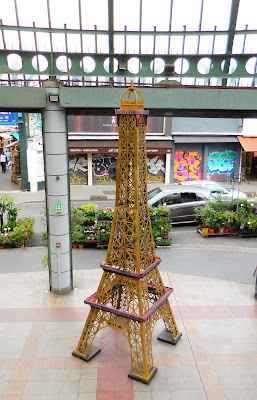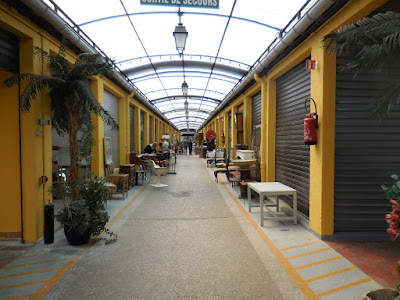 |
| A bronze alligator in the L'Entrepot market at St. Ouen. |
August 20, 2017 – 1860 must have seemed like a revolutionary
year in the Paris region. It was then
that many surrounding villages – or “communes” -- were annexed to Paris. That’s what happened to Grenelle, where I sit
now, in the 15th arroundissement, and it was true in Montmartre, on
the other side of the city.
But the annexation wasn’t so straight-forward in
Montmartre. Part of it was not annexed,
and instead it was added to the commune of St. Ouen. One entire commune, La-Chapelle-Saint-Denis,
was erased; its territory was divided up between St. Ouen, St. Denis, Paris,
and Aubervilliers.
This re-arrangement of suburbs and city must have been
confusing to the residents. But
yesterday, when we emerged from the Garibaldi metro station in St. Ouen, all seemed
to be clean and orderly – as if it had been that way for a long time.
 |
| An Eiffel Tower in the entry of the Malassis market. |
The centerpiece of the Garibaldi intersection is an almost
20th Century church called Notre-Dame-Du-Rosaire-de-Saint-Ouen. Its first stone was laid in 1898, but its
famous windows were products of 1909 to 1930; they were created by Charles
Lorin, Florentin Delabre, and Charles Champignuelle.
I love the gracious outlines of that church, and I love the
community park next to the it. The park
has plenty of mature trees and families with kids abound there.
We’d explored the church and the park in the past, and we
know from past visits how very much there is to see in St. Ouen, so we moved on
right away to the main attractions: the
flea markets of St. Ouen.
These so-called “fleamarkets,” or “puces,” are actually an
ongoing, nonstop, antiques fair. There
are tacky, actual flea markets outside of St. Ouen; you pass through them if
you take the metro line 4 to Porte de Clignancourt and walk the rest of the way
north to St. Ouen.
 |
We don’t recommend that route. We highly recommend that you take the metro
line 13 to Garibaldi in St. Ouen and walk south to the “puces.” That way you can avoid a lot of chaos and
shouting people. (I will admit, however, that the line 13 is heavily used since it goes some distance outside the City of Paris limits. Avoid line 13 in rush hour. Even on weekends, the train fills up.)
Like I said, in St. Ouen, there is order and
cleanliness.
I was surprised to learn from Wikipedia that the land upon which the St.
Ouen puces rest is owned by a man, Jean-Cyrille Boutmy, who bought it from Gerald
Grosvenor, the 6th Duke of Westminster. The antique dealers each rent their space on
a three-year lease.
The St. Ouen puces are rambling and seemingly endless. There is no way to see everything there in
one day. In fact, Wikipedia claims that
this is “the highest concentration of antique dealers and second-hand furniture
dealers in the world” (citation needed).
 |
| Notre-Dame-Du-Rosaire-de-Saint-Ouen |
The puces are arranged in markets. Some of the markets are buildings, and some
are covered spaces between buildings.
Yesterday, we visited markets called Le Passage, Jules Valles, L’Entrepot,
Paul Bert, Serpette, Dauphine, and Malassis.
We’ve visited those in the past, too, along with Biron and Vernaison. (Yesterday was the third time we'd visited St. Ouen.)
Many stalls in Dauphine and Malassis were closed for vacation
time. But there was still more than
enough to see. We kept on until we were
over-saturated with sights of fine furniture, paintings, rugs, glassware,
chandeliers, and collectible junk. By
then, it was time to head for home. The
puces are only open until 5:30PM, and it was nearly 5 by the time we boarded
the line 13 metro for home.
I’m not sure why some people characterize St. Ouen as
unsafe. I suspect that view is a
manifestation of racism. There are
plenty of people of color in St. Ouen. We've never felt unsafe in St. Ouen; on the contrary, we feel at home there.
 |
| The Square Marmottan is a lovely community park in St. Ouen. |
How the puces came to that area is an interesting
story. In the aftermath of that great
series of annexations in 1860, the rag-pickers – called chiffoniers – were pushed out of Paris. Beginning about 1870, they set up “shop” then
between the city limits and the first houses of St. Ouen.
Starting in about 1885, the city of St. Ouen put order to
the flea market area and officially opened the Marché aux Puces, or flea market.
Following some years of good publicity, the Sunday afternoon crowds of
shoppers grew.
With that came the growth of entertainment outlets – bistros
and cafés. Gypsies also occupied the
territory, and with entertainment venues now available, they shared their
music, known as “Gypsy Jazz.”
 |
| The bar at L'Atypic on the rue du Theatre in the 15th arrondissement. |
In fact, as we sat on the edge of a terrace at La Pericole café, having
a simple lunch yesterday, a well-dressed, older Gypsy woman came up to our
table and offered to read our palms, to tell us about our future. We politely declined.
Many more markets were added in the years after World War
II. Now the markets are open to the
public on Saturday, Sunday and Monday.
Two wholesale market for professionals (l’Usine and Lecuyer) open on week days (Wednesday through Friday
mornings).
So, you’re probably wondering if we bought anything. No, we did not. We’re looking for an old sign that says “Ascenseur”
to put by our elevator at home, but we haven’t found one yet. The closest thing we saw was an old plaque with
a warning to stay away from the elevator machinery.
In the evening, we had a very good dinner at L’Atypic on the
rue du Theatre – a great way to end an atypical day.

No comments:
Post a Comment